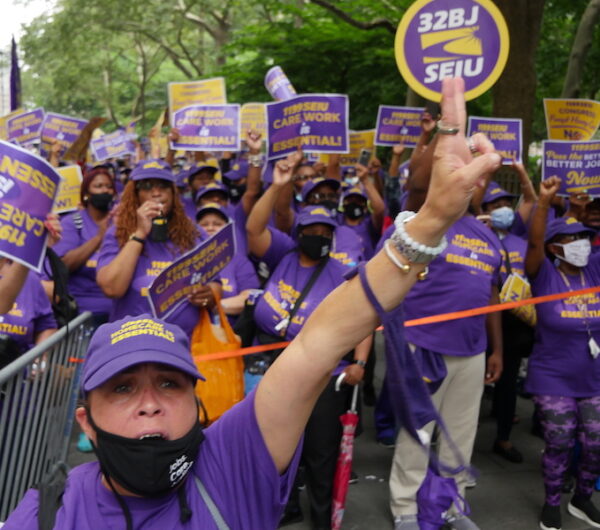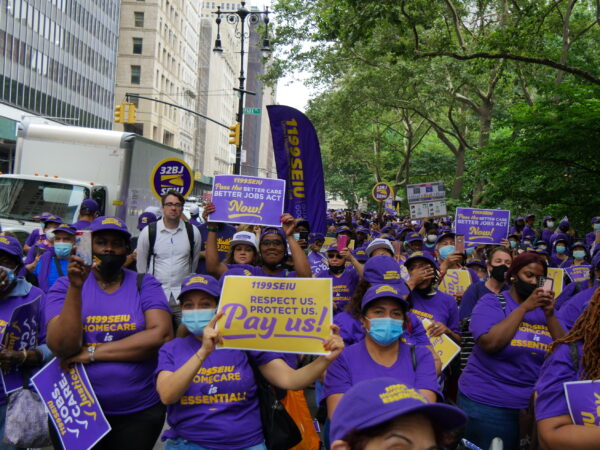New York, NY – Help — in the form of the Better Care Better Jobs Act — could finally be on the way for the more than 800,000 Americans across the country now languishing on a wait list for vital Home and Community Based Services [HCBS]—but if they’re kept waiting much longer, it’ll be because working women of color and immigrants also stand to be empowered like never before.

They are a largely mature workforce — almost a quarter of direct care workers are 55 and above — performing incredibly strenuous work every day. And yet, more than 40 percent of them can’t make ends meet without some form of public assistance. One in four was born outside the country.
Despite all this, the home care industry is on pace to become the fastest-growing source of jobs in the nation.
Over the last decade, the number of direct care workers in the U.S. grew by half — shooting up from 3 million in 2009, to roughly 4.6 million in 2019. The U.S. Bureau of Labor Statistics further projects the number of home health and personal care aides will jump nearly 35 percent over the next 10 years.
By way of contrast, the average growth rate for all other U.S. occupations is expected to rise by just 4 percent over the same time period.
S. 2210, the Better Care Better Jobs Act, seeks to invest $400 billion into expanding Medicaid HCBS, guaranteeing that more Americans will get the help they need to live fruitful, independent lives, while at the same time also helping to lift the workers who care for them out of poverty and removing significant barriers to unionization.
Woman of Color Workforce
Mary Kay Henry, head of the Service Employees International Union [SEIU], notes that the Better Care Better Jobs Act is the “first-ever jobs program aimed at providing career paths and good, union, living-wage jobs for a majority-women-of-color workforce.”
Those egalitarian features, however, are what make the Better Care Better Jobs Act so unpalatable to critics whose interests depend on keeping a large sector of society politically and economically disadvantaged.
“While privately some key Republicans acknowledge the need for more HCBS funding, it is unlikely any will vote for it. Especially since [President] Biden and Hill Democrats plan to partially pay for it and other provisions by raising taxes on corporations—a step congressional Republicans flatly reject,” Forbes’ Howard Gleckman notes.
In June, Pennsylvania Senator Bob Casey, co-sponsor of the Better Care and Better Jobs Act and chair of the Special Committee on Aging, sidestepped the grim reality that America’s economy has always depended on the exploitation of Black and Brown labor, when he called the direct care sector’s failure to pay workers a livable wage, while delivering for seniors and the physically challenged — inconsistent with “American values.”
“We can’t tolerate that,” Casey said. “We claim that we’re the greatest country in the world. We also claim that we really care about our seniors…We care about people with disabilities…How can we say that with any credibility when the people providing that care are paid $12-an-hour on average?”
How? Indeed.
Left Out of Social Security
Years of revolutionary labor unrest and agitation produced both the National Labor Relations Act and the Social Security Act of 1935, guaranteeing American workers the right to collective bargaining and a social safety net in their elder years.
But Black and Brown people, many laboring as farmworkers and domestic workers, were purposely excluded from both those pieces of groundbreaking legislation. The result has been generations of Black and Brown people sentenced to an ongoing cycle of institutionalized racism and poverty.
Two of the most recent slaps in the face include the Supreme Court’s disastrous decision to essentially trash the California Agricultural Labor Relations Act of 1975 and the Biden administration’s refusal to extend Covid workplace protections beyond healthcare workers.

Jaribu Hill, executive director of the Mississippi Workers’ Center for Human Rights and National Committee for Occupational Safety and Health member [COSH], specifically called the latter action “The brutal reality of racism at work. Black and Brown essential workers are devalued and unprotected,” he said.
Fellow COSH networkers leaders Erica Perry and Aaron Green meanwhile, observed, that the “government and corporate response to COVID-19 and treatment of Black workers were but one important example of this country’s commitment to extracting dignity from Black labor and maliciously using Black labor as the driving force of the economy.”
Last week, direct care workers in some 60 cities across the United States hit the streets and rallied for the Better Care Better Jobs Act.
“We have sacrificed a lot and risked our lives,” Anna Couch Superville told a large crowd of 1199SEIU members rallying outside New York City’s City Hall Park on July 13. “We home care workers are essential and we demand to be treated as such.”
Theo Braddy used to spend weeks on end waiting for his siblings to carry him down three flights of stairs after a football accident sent him into a nursing home when he was just 15-years-old.
“I had no opportunities to improve my situation,” the longtime disabilities activist and adjunct professor said in June. “I lived a life of isolation and unfulfilled dreams without Community and Home Based Services.”
The $400 Billion Better Care Better Job Act aligns with President Joe Biden’s highly touted American Jobs Plan — but he has to actually fight for it if he wants to see it fully realized.
New York City Mayor Bill de Blasio told direct home care workers gathered for last week’s Better Care Better Jobs Act rally that it’s time for Washington, DC to thank frontline heroes with a “real thank you.”
‘Time to Make History’
“Right now, the leaders in Washington know that they have the power to set things right [and] support home care workers” Hizzoner said. “To put that $400 billion in the pockets of people who are everyday heroes. This is the time to make history. This is how we move forward as a city and as a country that actually cares about families and cares for people in need. You are essential, it’s time Washington treats you as essential.”
Incredibly, Senator Casey, says he wants America’s direct home care system to be unrivaled.
“We don’t want America to be in second place…or tenth place — we want America to be number one in the world,” the senator said last month.
“Second Place? Tenth Place?” We should be so lucky.
Over the past year, the United States’ public health care systems fell seven spots on US News’ own Best Counties Report and currently ranks 22 in the world.
Lynn Weidner is a direct home care worker from Pennsylvania who lives paycheck to paycheck on a $12-an-hour salary. Weidner happens to be Caucasian, but the round-the-clock, live-in care that she provides her client is having a huge impact on personal life, too.
“If I get sick I just keep working,” she told reporters in June. “I don’t have a choice — I just keep going. I can’t go on vacation or buy a house. I sacrifice these things because I care about people. I sacrifice things I want in my own life, but it shouldn’t be like that.”
All of those factors, along with the huge emotional stress associated with direct caregiving, has contributed to industry turnover rates as high as 60 percent a year.
Advocates for the Better Care Better Jobs Act say that troubling situation, is helping to make the entire U.S. economy untenable.
“Our lives depend upon one another—we cannot truly thrive when structural racism, sexism and ableism are holding us back,” said Amber Smock, director of advocacy at Access Living, a disability rights and services organization based in Chicago. “People with disabilities know that their lives are at stake when the supports they need to live in the community disappear, and home services workers, who are majority Black and Brown women, receive poverty wages for their essential work.”
Ai-Jen Poo, director of Caring Across Generations and executive director of National Domestic Workers Alliance, says the high turnover rate in the direct care sector is creating “home care deserts” around the country.
The blue collar activist says a “paradigm shift” is happening in the country “whether people like it or not.”
“The need for care affects people across class,” she told me. “The country will shift to investing in the care economy — the only question is how fairly and how quickly. In order to do that, we need caregivers and other workers to step up. Care workers have been organizing for decades. We just need our elected officials to hear from their constituents.”
Senator Casey acknowledges “revenue generation” is an obstacle that supporters of the Better Care Better Jobs Act must overcome. Nevertheless, he also expressed his “wish” that “some Republicans would be willing to make this journey with us to get this done.”
“Those 820,000 people [on the HCBS wait list] are mostly from red states,” he noted.



